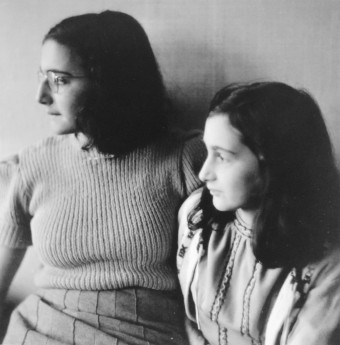This Day in History: October 30th- Margo and Anne
This Day In History: October 30, 1944
 Most people are familiar with the tragic story of Anne Frank, the young Jewish girl forced into hiding with her family when her older sister Margo received a call-up notice from the Central Office for Jewish Emigration to report to a labor camp in 1942. At the time, the family was living in the German occupied Netherlands, after having previously immigrated away from Germany in 1933 as the Nazi party rose to power.
Most people are familiar with the tragic story of Anne Frank, the young Jewish girl forced into hiding with her family when her older sister Margo received a call-up notice from the Central Office for Jewish Emigration to report to a labor camp in 1942. At the time, the family was living in the German occupied Netherlands, after having previously immigrated away from Germany in 1933 as the Nazi party rose to power.
They remained hidden until August 4, 1944 when their hiding place was ransacked by the Germans. Considered criminals for ignoring Margo’s call-up order and going into hiding, Otto and Edith Frank and their daughters were sentenced to the Punishment Barracks for hard labor and then sent to the Dutch Westerbork transit camp, arriving on August 8th. They were then transferred to Auschwitz on September 3, 1944.
When the Franks arrived at the camp, it was in the wake of a nightmarish frenzy of death – with countless thousands of prisoners being sent to the gas chambers on arrival. Remarkably, the Franks all survived the initial sorting, which saw 549 of the 1,019 people aboard their transport immediately sent to their deaths. The general rubric used by the Germans at the time in those sortings was- those who were fit for labor were allowed to live, and all others were killed. Those in their early to mid teens or younger were typically viewed as unfit for labor and immediately sent to the gas chambers, but Anne, who was 15 at the time, ended up being one of the youngest on her transport to be spared that fate.
The Frank family had remained in good health during their time in hiding, which probably helped them out in the initial sorting. Even though they had landed in the hell-on-Earth of Auschwitz, they hoped their continued usefulness as workers and the imminent arrival of the Allies would ensure their survival.
But on October 30, 1944, as the Russians advanced into Poland, many of the female prisoners of Auschwitz were deported to Bergen-Belsen in northern Germany. Margo and Anne Frank were among those forced to make the trip, but their mother, Edith, was left behind. Devastated at being separated from her daughters, Edith Frank succumbed to grief and starvation and died in early 1945. She had already been in poor health due to reportedly having given much of her meager rations to her daughters during their time at Auschwitz.
Margo and Anne arrived at the severely over-crowded and disease-ridden Bergen-Belsen where thousands of prisoners suffered from exposure in the bitter German winter and were starved down to human skeletons. Many people there, including the Frank sisters, were also infested with scabies, and typhus swept through the camp.
Rachel van Amerongen-Frankfoorder was a survivor of Bergen-Belsen. She knew Anne and Margot Frank and remembers their last days. She told documentary film-maker Willy Lindwer: “Typhus was the hallmark of Bergen-Belsen. Anne and Margot had those hollowed-out faces, skin over bone. They were terribly cold. They had the least desirable places in the barracks, below, near the door, which was constantly opened and closed. You could really see both of them dying.”
Survivor Janny Brandes-Brilleslijper gave another heartbreaking account, “First, Margot had fallen out of bed onto the stone floor. She couldn’t get up anymore. Anne died a day later. Three days before her death from typhus was when she had thrown away all of her clothes during dreadful hallucinations. That happened just before the liberation.”
Bergen-Belsen was liberated by the Allied 21st Army Group on April 15, 1945, long thought to be just weeks after the deaths of Anne and Margot Frank, but more recent scholarship suggests that their deaths occurred sometime in February. Most notable among the evidence is that the Franks seem to have contracted typhus in early February, and typically those in the camps would die within two weeks of contracting the disease.
Whatever the case, when the Allies liberated the camp, they also burned it to the ground to try to prevent the spread of typhus. Somewhere on the site, along with so many other innocent victims, the Frank sisters are buried in one of the mass graves.
After the war ended, Otto Frank returned to Amsterdam where he ultimately learned that none of his family had been among the survivors. It was there that he was also given his youngest daughter’s diary that had been saved by one of their former caretakers, Miep Gies, after their hiding place had been raided. Unfortunately, Margo’s diary was lost.
If you liked this article, you might also enjoy our new popular podcast, The BrainFood Show (iTunes, Spotify, Google Play Music, Feed), as well as:
- WWII Horror Files: Unit 731
- The Angel of Death: Josef Mengele
- The Soldier Who Voluntarily Became A Prisoner in Auschwitz
- A Tale of Two Brothers, Hitler’s Right Hand Man and the One Who Opposed Him
- The Mystery of the Forest Swastika and the Origin of the Symbol
| Share the Knowledge! |
|




